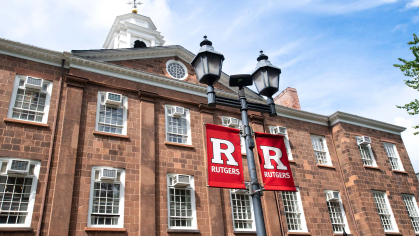Rutgers Board of Governors Approves 2.9 Percent Tuition and Fee Increase
Board approves $5.1 billion 2022-2023 budget
The Rutgers University Board of Governors today approved a $5.1 billion budget for the 2022-2023 academic year that includes a 2.9 percent increase in tuition and fees, nearly two-thirds below the current rate of inflation.
“We remain committed to providing excellence in academic experience and opportunity at an affordable and accessible price, and to ensuring that this necessary, measured increase does not affect our neediest students. Our focus on financial aid programs and net cost reflects that promise to our students, who have shown enormous resolve through the economic and other challenges of recent years,” said Mark A. Angelson, chair of the Rutgers University Board of Governors.
Tuition and fees, which account for more than 28 percent of university revenues, help fund academic programs and university services, including academic advising, library services, computing services, student health services, counseling and financial aid.
“This budget will support a vibrant and enriching university experience, including world-class academic instruction and research opportunities, unparalleled patient care and essential public service as we move forward in these challenging times,” Rutgers President Jonathan Holloway said.
For in-state, full-time arts and sciences undergraduates at Rutgers University-New Brunswick, tuition and fees for the upcoming academic year will be $16,263 before any financial aid is applied. At Rutgers University-Newark, tuition and fees for a typical full-time arts and sciences undergraduate will be $15,648 and, at Rutgers University-Camden, a typical arts and sciences undergraduate’s tuition and fees will be $16,112 before financial aid.
The majority of Rutgers undergraduate students – nearly three-quarters – received some form of student financial aid in academic year 2020-2021. As a result, the estimated net price to attend Rutgers-New Brunswick for in-state, first-year students receiving aid was approximately 48 percent of the published cost of attendance. The net price for a Rutgers-Newark student was 44 percent of the total cost and 39 percent for a Rutgers-Camden student.
For the three out of four Rutgers students who received some form of student financial aid, individual costs were reduced by federal, state, private or institutional financial aid programs, including need-based and merit-based grants, scholarships and loans.
This year, among the student financial aid programs are the Scarlet Promise Grants and undergraduate financial aid programs at Rutgers-New Brunswick, Rutgers-Newark and Rutgers-Camden that, combined with the New Jersey Garden State Guarantee, provide free tuition and mandatory fees for all eligible New Jersey students with family incomes below $65,000, and provide for significantly reduced tuition and fees for those whose families earn between $65,000 and $100,000.
In addition to tuition and fees (28 percent of revenues), other revenue sources in the new budget include patient care services (21.5 percent), the State of New Jersey (20.1 percent) and sponsored research (14.5 percent). Miscellaneous sources account for nearly 16 percent of revenues.
More than 77 percent of the budget is spent on the university’s core mission of student instruction, research, public service and patient care. The newly adopted budget spends 15.2 percent on administration, operations and maintenance and nearly 5 percent on auxiliary expenses, including housing and dining operations and student transportation. Athletics spending accounts for 2.7 percent of the budget.
“This is a reasonable budget that pays careful attention to expenditures during a time of many challenges, including rampant inflation and uncertainty about the continuing effects of the pandemic,” said Michael Gower, executive vice president, chief financial officer and university treasurer.


